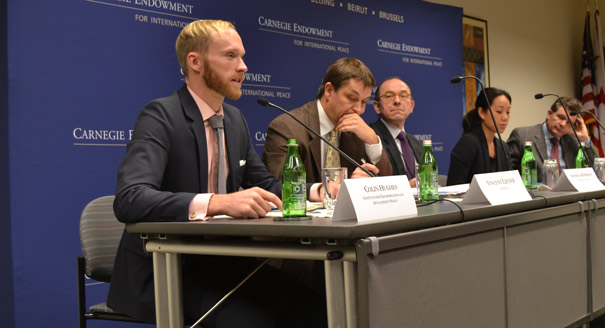Registration
You will receive an email confirming your registration.
Rapid urbanization in the twenty-first century has been accompanied by massively expanded private motorization. Effective urban transportation systems have significant benefits including cleaner air, less carbon, fewer traffic fatalities, and greater access to economic opportunities. The Carnegie Endowment brought together transportation experts from the United States and the European Union to discuss shared challenges and new opportunities in establishing institutions and policy frameworks to guide the development of urban transport systems.
Colin K. Hughes of ITDP, Vincent Leiner of CIVITAS, Siegfried Rupprecht of Rupprecht Consult, and Carnegie’s Shin-pei Tsay discussed the challenges of, and possible solutions to, shaping urban transport systems, with an emphasis on the experience of the European Union. Carnegie’s David Burwell moderated.
National Urban Transportation Policy
- Interwoven Links: Tsay highlighted the link between urbanization, transportation, and climate change.
- National Policy: She emphasized the need for national policy to guide local project development, funding, and evaluation. National policy on urban transport could help to build institutional capacity, coordinate land use and transportation decisions, and accelerate implementation.
- Creating Flexibility: Such a policy would not only benefit urban dwellers, but it would also provide more flexibility for each city’s economic activity, which in total generates 80 percent of global GDP, added Tsay.
Urban Mobility in the Developing World
- Supporting Cities: Hughes also argued for a national policy to support cities in funding, planning, and local capacity building to deal with rapidly rising urbanization rates.
- Major Challenges: In addition to population growth, Hughes said, developing countries are also facing high levels of motorization, which has resulted in more congestion, more road casualties, and more pollution. Countries like Mexico, Brazil, and India are beginning to enact national policy on urban mobility, but these nascent programs are facing issues in funding, accountability, and enforcement.
The Case of the EU
- Transportation and the European Union: Leiner presented the importance of transportation to the EU in terms of safety, economic activity, and pollution. EU objectives for urban mobility are relatively young compared to the EU’s comprehensive transportation policy, he said.
- A Common Framework: EU objectives for urban mobility provide a common framework under which each member state can develop sustainable urban mobility plans. Though the EU has had much success in demonstrating best practice projects across the Union, urban mobility at the supranational level is still challenged by the need to build consensus and the will to integrate local transport planning among the twenty-seven member nations, he added.
- France and the UK: The United Kingdom and France, both of which have a long history of centralized governance, have well established national frameworks to guide the development of local transport plans, Rupprecht said.
- Italy and Germany: Conversely, he added, nations which have historically been a federation of many cities or states, like Italy and Germany, today have less robust national legislation to guide localities in transport planning.
- Diversity of Context: The weakest point of the EU’s work in urban mobility is the diversity of the national governance contexts in which it must operate, Rupprecht concluded. The clear trend toward sustainable urban development among younger generations, however, may provide the best opportunity to overcome the differences in political culture.
New Opportunities
- Opportunities for Private Financing: National policy can help to provide the ideal environment for public-private partnerships to succeed in providing needed capital investment in transit projects, explained several participants. Value capture mechanisms through real estate development, exemplified in Hong Kong’s public transit network, constitute another innovative private financing tool, added several panelists.
- Augmenting Public Revenue Streams: Though highly politicized in the United States, a gas tax can provide transport systems with revenue for infrastructure construction and maintenance, stated several discussants. An employee tax, vehicle miles traveled tax, and increased parking prices are other options for funding projects.
- The Future of Urban Transport: The integration of mobility, public health, land use, and environmental policy are essential for building future transportation networks, asserted several presenters. Ideas like the super block, an urban area that stresses walkable neighborhoods, are innovative, context specific solutions to the challenges faced today.
